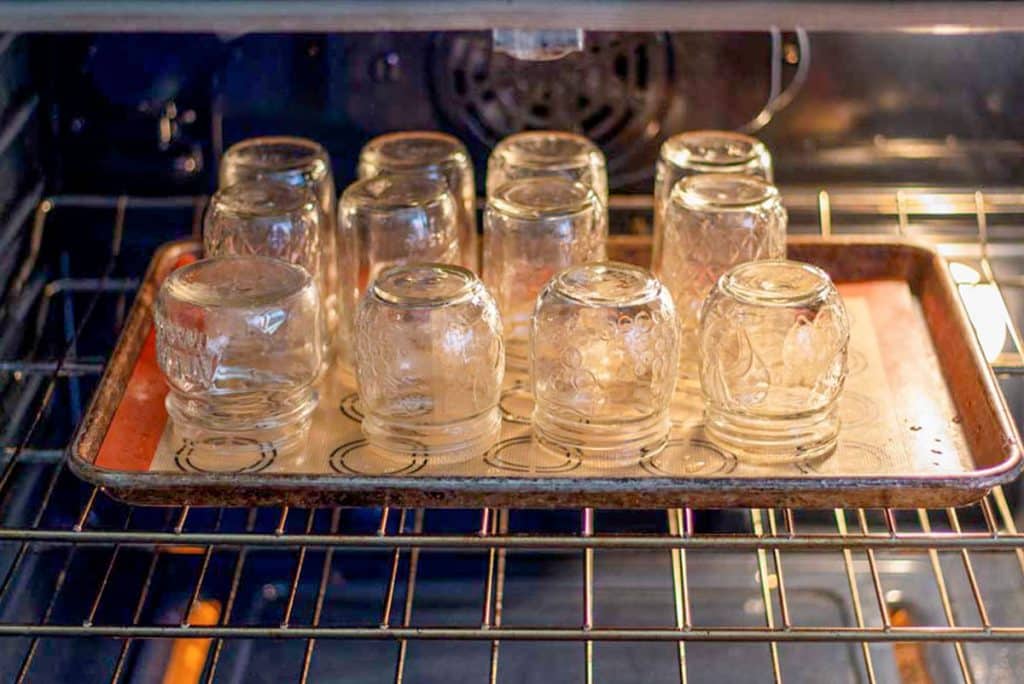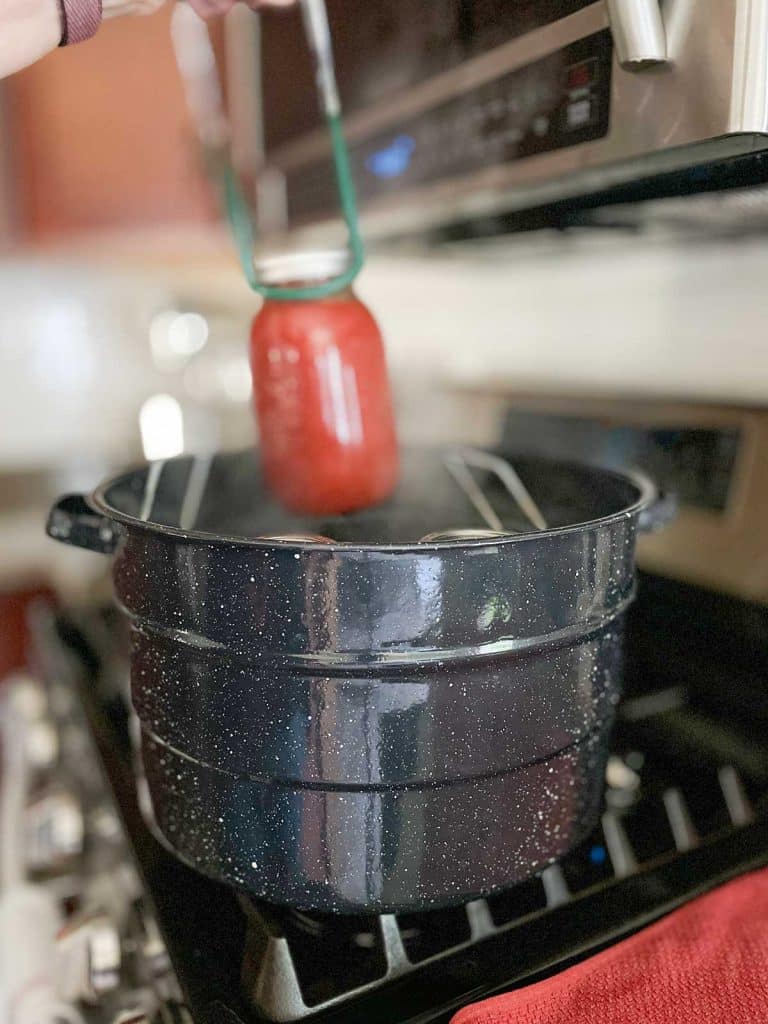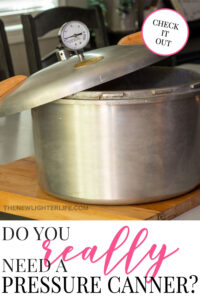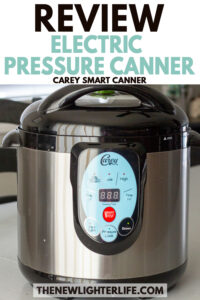Tomatoes are probably my favorite thing to grow in my garden. Because of my abundance, I’ve spent countless hours canning them. If you also have a love of tomatoes and want to preserve the taste of summer, canning tomatoes in a water bath is an excellent method to consider. This process allows you to enjoy your homegrown or farmer’s market tomatoes all year long while maintaining their delicious flavor and nutritional benefits. In this blog post, I’ll cover the various aspects of canning tomatoes in a water bath.
I’ll discuss the importance of adding acid to canned tomatoes and compare different acidic agents such as citric acid, vinegar, and lemon juice. Additionally, I’ll delve into the types of canners available for tomato preservation and weigh the pros and cons of pressure canning versus using a water bath method.
Further, I’ll provide detailed instructions on preparing fresh tomatoes for canning crushed tomatoes, whole tomatoes, tomato sauce, & tomato juice. I’ll also cover sterilizing jars and lids, and filling your jars with tomatoes before processing them in a boiling water bath canner. You’ll also get storage tips for long-lasting preserved foods and canning tomatoes FAQs. It’s all about tomatoes today, friends!
Pressure Canners vs. Water Bath Canners
When it comes to canning tomatoes, there are two methods to choose from – pressure canners and water bath canners. Let’s delve deeper into their functioning and the advantages they offer.
Using a Pressure Canner for Tomatoes
Pressure canners use high-pressure steam heat to kill harmful bacteria in a shorter amount of time compared to water bath canning. This method is especially useful for home canning low-acid foods like tomatoes without having to add extra acidifiers such as lemon juice or citric acid. Pressure-canned tomatoes will be more nutritious than water bath canned.
Using a Water Bath Canner for Tomatoes
A water bath canner involves immersing filled jars into boiling water for a longer processing time. While it takes longer than using a pressure canner, it still provides adequate preservation for tomato products when following proper guidelines such as adding the acid I previously mentioned.
- Note: Water bath canning is not recommended for all types of food items due to its lower temperature processing. Pressure canning raises the temperature high enough for low-acid foods to kill any bacteria that can cause food-borne illnesses.
Though I mentioned that pressure-canned tomatoes are more nutritious (according to the USDA) water bath canned tomatoes are still delicious and nutritious over their store-bought counterparts.
The Importance of Adding Acid to Canned Tomatoes
When it comes to home canning, adding acid to your canned tomatoes is crucial for safe storage. Many tomato varieties lack the necessary acidity levels to prevent the growth of harmful bacteria during long-term storage periods. That’s where citric acid or vinegar comes in.
Understanding the Role of Acidity in Food Preservation
Acidity is key to preventing the growth of harmful bacteria like botulism in canned foods. The higher the acidity level, the safer your canned tomatoes will be. That’s why it’s important to add acid to your tomato products before canning them.
Citric Acid, Vinegar, & Lemon Juice: Pros and Cons
- Citric acid: A natural preservative found in citrus fruits like lemons and oranges that provides a consistent acidity level without significantly altering the flavor. It’s a popular choice among home canners and is recommended by canning experts worldwide.
- Vinegar (5% acidity): An affordable and readily available option for adding acidity to your canned tomatoes. However, using vinegar results in a noticeable change in flavor.
- Lemon juice: Bottled lemon juice is commonly used in preserving tomato products. It is a versatile ingredient that is often preferred by those who want a natural and flavorful alternative when canning tomatoes.
How to Add Acid to Canned Tomatoes
For a pint of tomatoes, add 2 tablespoons vinegar, 1 tablespoon of lemon juice, or 1/4 teaspoon citric acid; for quart jars, use 4 tablespoons vinegar, 2 tablespoons of lemon juice, or 1/2 teaspoon citric acid. Be sure to use bottled lemon juice or citric acid, as fresh lemon juice may vary in acidity levels. Add the acid to your sterilized jars just before filling with your tomatoes and processing them in a water bath canner.
Below is a chart for the amounts needed for your tomatoes depending on the size of the jar.
| Size | Bottle Lemon Juice | Vinegar (5% acidity) | Citric Acid |
|---|---|---|---|
| Pint | 1 tablespoon | 2 tablespoons | 1/4 teaspoon |
| Quart | 2 tablespoons | 4 tablespoons | 1/2 teaspoon |
Step-by-Step Canning Tomatoes in Water Bath
In order to safely process home-canned tomato products in a water bath canner you’ll need to do the following:
1. Preparing Your Equipment & Sanitize Your Jars
Wash and sanitize your canning jars and lids (if using reusable lids such as Tatler).
To sanitize your jars you may do one of the following:
- Oven – Set the oven to 275°F. Place canning jars on a banking tray (not touching each other) & “Bake” for 20 minutes.
- Dishwasher – Run jars through the dishwasher’s rinse or sanitize cycle.
- Boil – in a pot of clean water, boil jars for at least 11 minutes.
- Microwave – Leave jars slightly wet and microwave for 30 to 45 seconds.

Ensure all canning equipment & tools are properly cleaned.
Clean your work area and gather all your supplies.
2. Preparing Your Tomatoes
Thoroughly wash tomatoes and cut off any portions that appear discolored or damaged.
Depending on your intended tomato product, (crushed, whole, diced, or quartered) you will want to blanch your tomatoes at the start of your preparation.
Blanching Technique for Easy Tomato Skin Removal
- Fill a large saucepan with water and bring it to a boil.
- Dip tomatoes in boiling water for 30-60 seconds or until their skins start to loosen.
- Immediately transfer them to a bowl of ice-cold water to stop the cooking process.
- Gently peel off the skins using your fingers or a paring knife.
- Cut out the core of the tomatoes
- Continue to the crushed tomatoes, whole, diced, or quartered tomatoes sections
Note: You do not need to blanch your tomatoes if you are making tomato sauce or tomato juice.
Crushed Tomatoes
- Cut your blanched tomatoes into quarters.
- Place 1/4 of these tomatoes into a large saucepan and turn it to medium-low heat.
- Crush the added tomatoes and continue to stir them so they do not burn.
- Add the remaining blanched tomatoes cut into quarters into the saucepan and let the liquid soften and cook them down slightly.
- Continue cooking and stirring tomatoes until they are heated thoroughly.
Continue to the section about filling your jars.
Whole, Dice, or Quarter Tomatoes
Take your blanched tomatoes and dice or quarter them. You may also can them whole if they are golf-ball size or smaller.
Continue to the section about filling your jars.
Tomato Sauce
To achieve the perfect consistency for your tomato sauce, you will need to cook down your tomatoes. Since this is a lengthy process, I prepare my tomato sauce one day and can the next.
Note: You do not need to blanch your tomatoes for sauce.
- Remove the core of your tomatoes and cut them into quarters.
- Add cut tomatoes to a large saucepan.
- Once tomatoes are at a constant boil, cook for 5 minutes. Stir frequently to prevent burning.
- Process tomatoes through a sieve or food mill to remove the skin, & seeds.
- Return your sauce to a roaster, slow cooker, or large saucepan and low simmer, stirring periodically to prevent burning.
- Cook your sauce until it is reduced to half.
Continue to the section about filling your jars.
Tomato Juice
Note: You do not need to blanch your tomatoes for juice.
- Remove the core of your tomatoes and cut them into quarters.
- Add cut tomatoes to a large saucepan.
- Once tomatoes are at a constant boil, cook for 5 minutes. Stir frequently to prevent burning.
- Process tomatoes through a sieve or food mill to remove the core, skin, & seeds.
- Reserve hot tomato mixture (juice) for canning.
Continue to the section about filling your jars.
3. Preparing Your Water Bath Canner

- Fill your clean water bath canner with enough hot water to cover the tops of your filled jars with at least 2 inches of water.
- Bring water to a boil.
- Add 2 tablespoons of vinegar to boiling water, which eliminates hard water deposits that will cloud the outside of your jars.
4. Filling Canning Jars with Prepared Tomatoes
Now is the time to add that acid we talked about earlier. Pour the correct amount of the following acid agents directly into each jar before adding your tomato product:
| Size | Bottle Lemon Juice | Vinegar (5% acidity) | Citric Acid |
|---|---|---|---|
| Pint | 1 tablespoon | 2 tablespoons | 1/4 teaspoon |
| Quart | 2 tablespoons | 4 tablespoons | 1/2 teaspoon |
Carefully ladle your hot tomato mixture or whole tomatoes into your hot jars, ensuring adequate headspace remains (about 1/2 inch). Note: If canning whole, diced, or halved tomatoes, fill the jar with tomatoes and firmly pack. Top with boiling water to reach the adequate headspace.
Run a non-metallic spatula, skewer, or chopstick around the inside edges of each filled jar to remove any air bubbles trapped inside.
Wipe off any residue from the rim with a damp cloth. Place prepared lids onto clean rims. Screw bands securely but not too tight onto jars’ mouths to finger-tight. This allows room for expansion during processing.
5. Processing Jars in Water Bath Canner
- With a jar lifter, gently submerge your filled and lidded jars into the boiling water bath canner.
- Ensure that your jars are covered by at least 1 inch of water.
- Place the canner lid on the canner and bring the water to a rolling boil again.
- Reduce heat slightly, so that your canner doesn’t boil over but stays at a rolling boil.
- Set your timer for the proper processing time below.
- Once you’ve water-bathed your tomatoes for the required time, turn off your burner and let the canner sit for 5 minutes. This prevents such a significant shock to your tomatoes, which results in seeping out of the jar through the lid.
Crushed Tomatoes – Processing Times:
| Jar Size | 0-1,000 ft | 1,001 – 3,000 ft | 3,001 – 6,000 | Above 6,000 |
|---|---|---|---|---|
| Pint | 35 minutes | 40 minutes | 45 minutes | 50 minutes |
| Quart | 45 minutes | 50 minutes | 55 minutes | 60 minutes |
Whole Tomatoes – Processing Times:
| Jar Size | 0-1,000 ft | 1,001 – 3,000 ft | 3,001 – 6,000 | Above 6,000 |
|---|---|---|---|---|
| Pint | 40 minutes | 45 minutes | 50 minutes | 55 minutes |
| Quart | 45 minutes | 50 minutes | 55 minutes | 60 minutes |
Tomato Sauce – Processing Times:
| Jar Size | 0-1,000 ft | 1,001 – 3,000 ft | 3,001 – 6,000 | Above 6,000 |
|---|---|---|---|---|
| Pint | 35 minutes | 40 minutes | 45 minutes | 50 minutes |
| Quart | 40 minutes | 45 minutes | 50 minutes | 55 minutes |
Tomato Juice – Processing Times:
| Jar Size | 0-1,000 ft | 1,001 – 3,000 ft | 3,001 – 6,000 | Above 6,000 |
|---|---|---|---|---|
| Pint | 35 minutes | 40 minutes | 45 minutes | 50 minutes |
| Quart | 40 minutes | 45 minutes | 50 minutes | 55 minutes |
6. Removing Jars from the Canner

- Once 5 minutes have passed, remove your processed jars from the canner with a jar lifter and place them on a towel.
- If using a Tatler reusable lid, screw your band on tight once it’s removed from the canner so it will seal.
- If using a metal lid do NOT tighten your jar’s band. (you may hear your jars pop as they seal)
- Leave your jars undisturbed for 12 to 24 hours.
7. Storing Canned Goods
- Check the seals of your canned tomatoes before storing them.
- Metal disposable lids – if your lids’ center “button” does not flex up and down when pressed in the center, it is sealed.
- Reusable plastic lids with gaskets – centers of these types of lids will be slightly “sucked” down.
- Test for both types – a fail-safe check to see if your jars are properly sealed, check them by slowly lifting the jar by the lid. If the lid remains in place, it is sealed. If it comes off, you will need to freeze or consume your canned goods and they are not shelf stable.
- Keep your bands off your canned tomatoes for storage. This helps to identify if there are any spoilage issues and also keeps your bands from rusting or becoming damaged.
- For optimal shelf life, store canned goods in a cool, dark place like a pantry or basement with temperatures between 50°F and 70°F (10°C -21°C).
- Keep them away from direct sunlight or heat sources that could affect their quality over time.
- Remember to label each jar with the contents and date of processing for easy reference.
FAQs in Relation to Canning Tomatoes in Water Bath
Can You Water Bath Can Tomatoes?
Yes, tomatoes can be safely preserved using the water bath canning method, which retains their fresh taste and ensures long-term storage.
It’s important to add acidifiers like lemon juice or citric acid to maintain safe acidity levels and process the jars for the appropriate amount of time based on jar size and altitude.
Refer to the National Center for Home Food Preservation guidelines for processing times at different altitudes.
How Long to Process Canned Tomatoes in Water Bath?
The processing time for canned tomatoes in a water bath varies based on jar size and altitude, but generally, pint jars take 35-40 minutes, while quart jars require 45-50 minutes at sea level.
Adjust processing times accordingly for higher altitudes and refer to reliable sources for tested recipes and guidelines.
What Can Go Wrong When Canning Tomatoes?
Potential issues when canning tomatoes include spoilage due to improper sealing or insufficient acidity levels, resulting in bacterial growth.
- To avoid these problems, add an appropriate amount of acidifier (lemon juice or citric acid).
- Sterilize jars and lids properly and ensure correct headspace and tight seals.
Do You Need to Add Lemon Juice When Canning Tomatoes in a Water Bath?
Yes, lemon juice is necessary when canning tomatoes using a water bath method because it increases the acidity level required for safe preservation.
You may also use vinegar or citric acid as alternatives, but ensure proper amounts are added according to tested recipes from reliable sources like Ball Canning.
Conclusion
Are you interested in water bath canning tomatoes? Remember to add acid for safety – citric acid, vinegar, or lemon juice will work. Tomatoes can be preserved using either pressure canning or water bath canning. Each method has its advantages and disadvantages. However, water bath canners are more readily available. To preserve tomatoes using a water bath canner, follow my instructions and savor those tasty tomatoes all year long.







1 thought on “Canning Tomatoes in Water Bath: A Complete Guide”